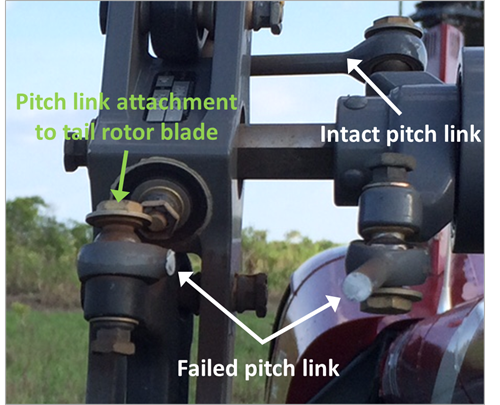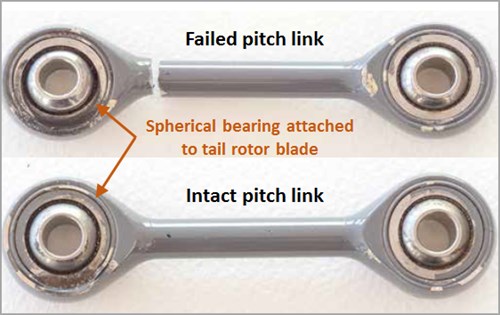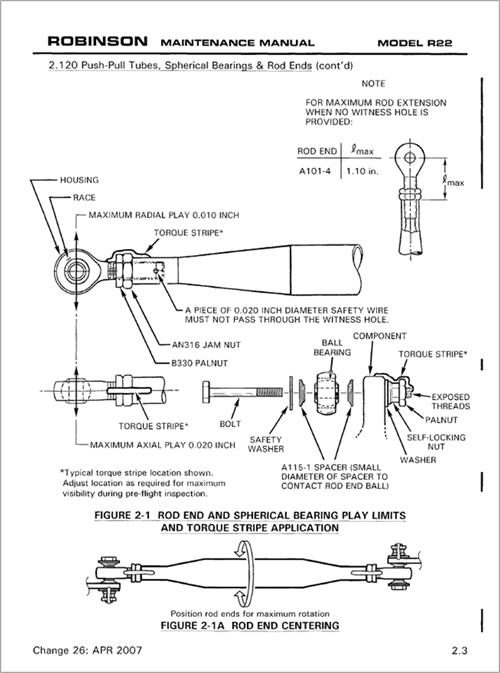What happened
On 18 November 2014, at about 1728 Central Standard Time (CST), a Robinson R22 helicopter, registered VH-HPH (HPH), departed from La Belle Downs Station, Northern Territory, for a local flight to check the progress of a bush fire, with the pilot and one passenger on board.
About two minutes into the flight, on climb and at about 300 ft above ground level, the pilot felt a vibration through the tail rotor pedals. The pilot decided to return to La Belle Downs station, turned the helicopter to the right and started a descent. The pilot was unable to stop the turn and the helicopter continued to descend and turn to the right. The helicopter started to spin in a tight circle and completed between five and six rotations before landing hard, bouncing once and then coming to a stop. The pilot performed the shutdown procedure and the pilot and passenger exited the helicopter. The pilot and passenger were uninjured. The helicopter was substantially damaged, including damage to the tail boom and both skids.
Pilot comment
After landing, the pilot observed that the tail rotor pitch link[1] had failed (Figure 1).
Prior to the first flight of the day, the pilot reported carrying out a daily inspection without finding any defects. The pilot had then flown HPH for approximately 2 hours, prior to the accident flight.
Figure 1: Failed tail rotor pitch link

Source: Aircraft operator, annotated by the ATSB
Operator investigation
An examination of the tail rotor pitch links was conducted on behalf of the helicopter operator by a consultant in engineered-system failure analysis and the following was found (Figure 2):
- Alternating stress in the failed pitch link resulted in the initiation and propagation of a fatigue crack.
- The alternating stress in the pitch link resulted from failure of the spherical bearing to provide a low friction connection between the end of the tail rotor blade and the pitch link.
- The failed pitch link spherical bearing attached to the tail rotor had extensive wear. Axial wear of the spherical bearing was measured to be about 0.108 inch (2.743 mm).
- The intact pitch link spherical bearing attached to the tail rotor also showed signs of extensive wear. Axial wear of the spherical bearing was measured to be about 0.041 inch (1.041 mm).
- The factors that influence the rate of wear in the spherical bearing that attaches the tail rotor blade to the pitch link would not be expected to vary from helicopter to helicopter.
- No physical explanation was found as to why the specified inspection procedures (R22 Maintenance Manual, Chapter 2 Inspection, section 2.410) failed to detect bearing wear. Possible explanations beyond what could be ascertained by the examination were that the helicopter was operated in an exceptionally abrasive environment or the Teflon bearing lining was affected by some cleaning action.
Figure 2: HPH tail rotor pitch links

Source: Aircraft operator, annotated by the ATSB
HPH maintenance documentation
About 443 hours prior to the accident, at a 50 hourly inspection, the tail rotor pitch links (part number B345-3) were found to be unserviceable. Two new pitch links, with the same part number, were installed. The pitch link had failed about 2 hours prior to the next scheduled 100 hourly inspection. The maintenance release indicated that all the required daily inspections had been carried out and that there were no outstanding maintenance issues.
Manufacturer comment
The helicopter manufacturer was only aware of one other similar failure that occurred about 10 years ago. The manufacturer believed that the failure was as a result of the axial wear (about five times more than permitted) allowed binding to occur, with resultant fatigue failure to the pitch link.
Pilot operating handbook
Robinson Model R22 Pilot’s Handbook, Section 4 Normal Procedures Daily or Prefight checks, dated 20 April 2007 page 4-3, included an item to check the tail rotor pitch links for “No looseness”.
Robinson maintenance manual
The Robinson Maintenance Manual Model R22 contains inspection requirements to be conducted at the 100-hour or annual inspection. Section 2.410 Inspection procedures and checklist item 12. Rotor Hub Hinge Bolts, dated October 2014, required the condition of the pitch links and rod ends to be inspected. This inspection was to be in accordance with section 2.120 Push-Pull Tubes, Rod Ends, and Spherical Bearings (dated October 2014), with reference to Figure 2-1 (reproduced below in Figure 3). The inspection needed to meet the following conditions:
- the maximum allowed axial play of 0.020 inch (0.508 mm). The axial play of HPH’s failed pitch link was about 0.108 inch (2.743 mm) and the intact pitch link was about 0.041 inch (1.041 mm)
- the maximum radial play of 0.010 inch (0.254 mm) for the rod end spherical bearings
- with no looseness between the bearing outer race and the rod end housing.
The maintenance manual also contained a caution that the Teflon-lined bearings must not be lubricated or cleaned with solvent.
Figure 3: Robinson maintenance manual spherical bearing limits

Source: Robinson
ATSB comment
CASA SDR database search
The operator reported to the ATSB that the R22 helicopter tail rotor pitch links had been failing regularly in mustering operations. CASA provided information from their Service Difficulty Report (SDR) database from 1983 to 2014. The database showed three previously reported defects with the same part number tail rotor pitch link as HPH where the pitch link had failed (Table 1). Two of the failures had occurred in flight.
Table 1: CASA SDR database - Tail rotor pitch link failures
| month/year of SDR | Failure | Time since new (hours) | Part number pitch link | Operation |
| 09/2009 | Tail rotor pitch link failed in flight. | 434 | B345-3 | Mustering |
| 11/2009 | Tail rotor pitch link failed in flight. Spherical bearing attached to the tail rotor blade was found worn to limits. | 562 | B345-3 | Mustering |
| 04/2014 | During the scheduled 100 hourly inspection the tail rotor pitch link fractured near the spherical bearing attached to the tail rotor blade. | 289 | B345-3 | Unknown |
CASA reported two important points in relation to the CASA SDR system:
in the case of the Robinson R22, there is no legislation requiring the manufacturer to be notified of the tail rotor pitch link failures in Australia that have been reported to CASA. While there is no requirement to provide this information, CASA usually provides data dumps of defect reports on an annual basis to North American NAAs [National Airworthiness Authorities including the US Federal Aviation Administration and Transport Canada].
CASA encourages the industry to pass the defect information to the approval holder [manufacturer] and, as part of any follow up action CASA is likely to send the information to the approval holder [manufacturer], foreign or domestic.
Safety message
Continuing airworthiness relies on inspections identifying damage so that parts can be repaired or replaced prior to failure. Therefore, scheduled maintenance inspections and the pilot’s daily inspection are a central element of the continuing airworthiness of the aircraft.
Regulators and aircraft manufacturers depend on accurate data to ensure the ongoing continued airworthiness of the aircraft. It is important that defects are reported to CASA through the Service Difficulty Reports (SDR) system, and to the manufacturer, so issues can be identified and rectified.
Aviation Short Investigations Bulletin - Issue 42
Purpose of safety investigationsThe objective of a safety investigation is to enhance transport safety. This is done through:
It is not a function of the ATSB to apportion blame or provide a means for determining liability. At the same time, an investigation report must include factual material of sufficient weight to support the analysis and findings. At all times the ATSB endeavours to balance the use of material that could imply adverse comment with the need to properly explain what happened, and why, in a fair and unbiased manner. The ATSB does not investigate for the purpose of taking administrative, regulatory or criminal action. TerminologyAn explanation of terminology used in ATSB investigation reports is available here. This includes terms such as occurrence, contributing factor, other factor that increased risk, and safety issue. Publishing informationReleased in accordance with section 25 of the Transport Safety Investigation Act 2003 Published by: Australian Transport Safety Bureau © Commonwealth of Australia 2015
Ownership of intellectual property rights in this publication Unless otherwise noted, copyright (and any other intellectual property rights, if any) in this report publication is owned by the Commonwealth of Australia. Creative Commons licence With the exception of the Coat of Arms, ATSB logo, and photos and graphics in which a third party holds copyright, this publication is licensed under a Creative Commons Attribution 3.0 Australia licence. Creative Commons Attribution 3.0 Australia Licence is a standard form licence agreement that allows you to copy, distribute, transmit and adapt this publication provided that you attribute the work. The ATSB’s preference is that you attribute this publication (and any material sourced from it) using the following wording: Source: Australian Transport Safety Bureau Copyright in material obtained from other agencies, private individuals or organisations, belongs to those agencies, individuals or organisations. Where you wish to use their material, you will need to contact them directly. |
__________
- There are two tail rotor pitch links, one for each tail rotor blade. The pitch link connects the blade to the tail rotor pitch control assembly. The tail rotor pitch control assembly is connected via push pull controls to the pedals in the cockpit, which the pilot moves for directional control.


